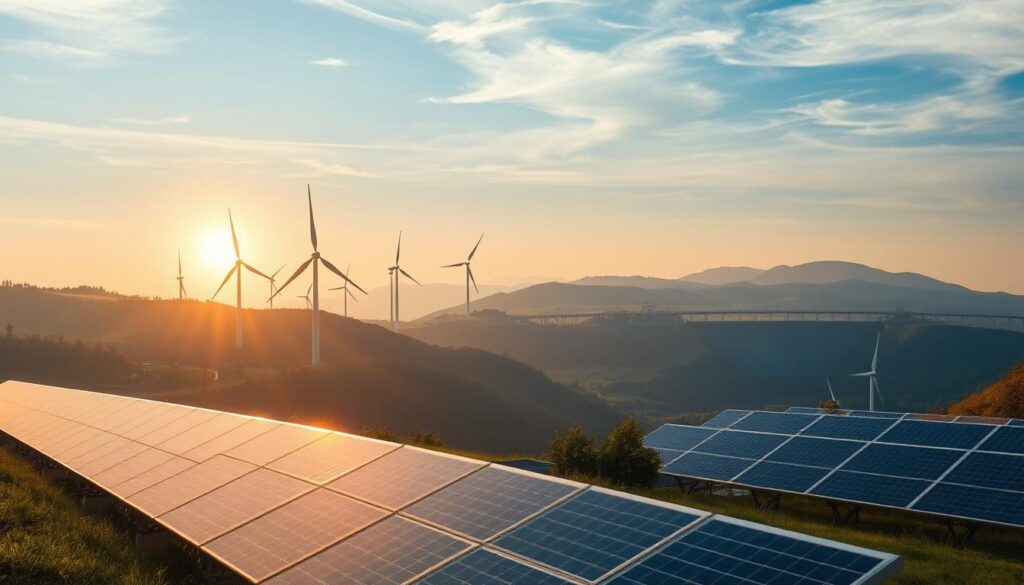As the world shifts towards a more sustainable future, the role of energy engineering in powering this change is becoming increasingly vital. Energy engineering is at the forefront of transforming how we produce, consume, and conserve energy.
This transformation is driven by innovative renewable energy technology and energy efficiency measures. As we move forward, the importance of sustainable energy solutions cannot be overstated.
Key Takeaways
- Innovative renewable energy technologies are driving the shift towards a sustainable future.
- Energy efficiency measures are crucial for reducing energy consumption.
- Sustainable energy solutions are key to mitigating climate change.
- Energy engineering plays a vital role in the development of sustainable energy.
- The future of energy depends on the successful implementation of these technologies.
The Science Behind Energy Engineering
Understanding the science behind energy engineering is crucial for appreciating its role in shaping a sustainable future. Energy engineering applies scientific knowledge to develop efficient solutions for energy production, transmission, and consumption.
Fundamental Principles and Core Concepts
The fundamental principles of energy engineering principles involve the application of scientific knowledge to optimize energy use. Key concepts include energy conversion, transmission, and storage. These principles are crucial for developing efficient energy systems.
- Energy conversion processes
- Efficient transmission technologies
- Advanced energy storage systems
By understanding these core concepts, energy engineers can design systems that minimize energy loss and maximize output.
The Evolution from Traditional to Modern Approaches
The field of energy engineering has evolved significantly, transitioning from traditional energy approaches that relied heavily on fossil fuels to modern energy approaches that prioritize renewable energy sources and energy efficiency. This evolution is driven by advances in technology, changing energy policies, and growing environmental concerns.
Some key developments in modern energy approaches include:
- Renewable energy technologies
- Energy-efficient systems
- Smart grid technologies
The shift towards modern energy approaches is crucial for reducing our reliance on fossil fuels and mitigating climate change.
Renewable Energy Technologies Transforming the Industry
As the world shifts towards a more sustainable future, renewable energy technologies are playing an increasingly crucial role in transforming the energy industry. These technologies are not only reducing our reliance on fossil fuels but also mitigating the environmental impacts associated with traditional energy production.
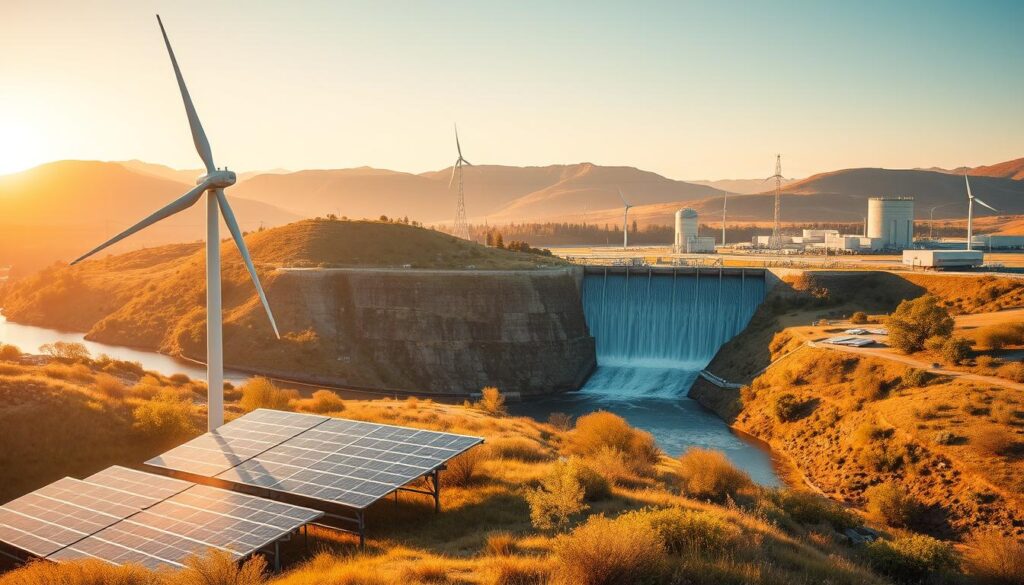
Solar Power Engineering Innovations
Solar power engineering has seen significant advancements in recent years, making it a more viable and efficient source of renewable energy. Two key areas of innovation are photovoltaic systems and concentrated solar power solutions.
Photovoltaic Systems Advancement
Photovoltaic (PV) systems have become more efficient and cost-effective, allowing for wider adoption in both residential and commercial settings. Advances in PV technology have led to higher energy conversion rates and reduced maintenance costs.
Concentrated Solar Power Solutions
Concentrated Solar Power (CSP) systems use mirrors or lenses to focus sunlight, generating heat or electricity. CSP technology has improved significantly, offering high efficiency and scalability for large-scale energy production.
Wind Energy Systems and Optimization
Wind energy systems continue to be a vital component of the renewable energy mix. Optimizations in turbine design and wind farm layout have led to increased energy production and reduced costs. Modern wind turbines are now capable of generating more power than ever before, making wind energy a competitive alternative to fossil fuels.
| Technology | Advantages | Challenges |
|---|---|---|
| Photovoltaic Systems | High efficiency, low maintenance | Intermittent energy source |
| Concentrated Solar Power | Scalable, high energy output | High initial investment |
| Wind Energy | Abundant resource, cost-effective | Intermittent, visual impact |
Hydroelectric and Geothermal Applications
Hydroelectric power remains one of the oldest and largest sources of renewable energy. Modern hydroelectric facilities are being optimized with advanced turbine technology and environmental considerations in mind. Geothermal energy, which harnesses heat from the Earth, is another significant renewable resource, particularly suited to regions with substantial volcanic activity.
Emerging Technologies: Tidal and Biomass Energy
Tidal energy, which captures the power of ocean tides, is an emerging technology with vast potential. Biomass energy, produced from organic materials, offers another promising avenue for renewable energy. Both technologies are in the early stages of development but could play significant roles in the future energy landscape.
Energy Efficiency Measures for Sustainable Development
Energy efficiency plays a significant role in promoting sustainable development and reducing environmental footprint. As the world moves towards a more sustainable future, implementing energy efficiency measures becomes increasingly important.
Industrial Process Optimization Techniques
Industrial processes consume a significant amount of energy, and optimizing these processes can lead to substantial energy savings. Techniques such as process integration, energy recovery, and system optimization can be employed to reduce energy consumption. For instance, implementing cogeneration systems can improve energy efficiency by utilizing waste heat for power generation or heating purposes.
Moreover, industries can adopt energy management systems to monitor and control energy usage in real-time, enabling them to identify areas of inefficiency and implement corrective measures.
Residential and Commercial Building Efficiency
Residential and commercial buildings are significant consumers of energy, and improving their efficiency is crucial for sustainable development. This can be achieved through various measures, including the use of energy-efficient appliances, building insulation, and smart home energy management systems.
Smart Home Energy Management
Smart home energy management systems enable homeowners to monitor and control their energy usage remotely, optimizing energy consumption and reducing waste. These systems can integrate with various smart devices, such as thermostats and lighting systems, to create a highly efficient home environment.
Commercial Facility Optimization
Commercial facilities can also benefit from energy efficiency measures, such as LED lighting, energy-efficient HVAC systems, and building automation systems. These measures not only reduce energy consumption but also improve the overall comfort and productivity of building occupants.
By implementing these energy efficiency measures, we can significantly reduce our environmental footprint and move towards a more sustainable future.
Green Building Design and Sustainable Architecture
The future of construction lies in green building design and sustainable architecture, transforming our buildings and our planet. As the world grapples with environmental challenges, the importance of sustainable practices in building construction cannot be overstated.
Energy Conservation through Design
Passive design strategies play a crucial role in energy conservation. By maximizing natural light and optimizing heating and cooling through thoughtful building orientation and design, buildings can significantly reduce their energy consumption. This approach not only reduces the reliance on mechanical systems but also creates more comfortable and healthy indoor environments.
Active Systems and Renewable Integration
Beyond passive design, active systems and the integration of renewable energy sources are pivotal in enhancing a building’s sustainability. This includes the use of solar panels, wind turbines, and other renewable energy technologies to power buildings.
Building-Integrated Renewable Energy
Building-integrated renewable energy systems are becoming increasingly popular. These systems seamlessly integrate renewable energy generation into the building’s design, such as solar panels integrated into the building facade or roof.
High-Performance Building Envelopes
A high-performance building envelope is critical for energy efficiency. It includes advanced materials and designs that minimize heat loss in winter and heat gain in summer, reducing the need for heating and cooling.
By combining passive design strategies, active systems, and innovative technologies like building-integrated renewable energy and high-performance building envelopes, the construction industry can significantly reduce its environmental footprint. This holistic approach to green building design and sustainable architecture is not only beneficial for the planet but also enhances the well-being of building occupants.
Energy Management Strategies for Organizations
Effective energy management is crucial for organizations aiming to reduce their environmental footprint. As energy costs continue to rise and environmental concerns grow, implementing robust energy management strategies has become a priority for businesses worldwide.
Energy Auditing and Performance Assessment
Energy auditing is a critical first step in identifying areas where organizations can improve their energy efficiency. This process involves a thorough examination of energy usage patterns, equipment, and systems to pinpoint opportunities for energy savings. By conducting regular energy audits, organizations can develop targeted strategies to reduce their energy consumption and costs.
Implementation of Energy Management Systems
Implementing an energy management system (EnMS) is a systematic approach to managing energy use. It involves setting energy performance targets, identifying opportunities for improvement, and monitoring progress. An EnMS helps organizations streamline their energy usage, reduce waste, and achieve significant cost savings.
ISO50001 and Certification Processes
ISO50001 is an international standard that provides a framework for organizations to implement an effective EnMS. Achieving ISO50001 certification demonstrates an organization’s commitment to energy management and continuous improvement. The certification process involves a thorough audit of the organization’s energy management practices and compliance with the standard’s requirements.
Continuous Improvement Methodologies
Continuous improvement is a key aspect of effective energy management. Organizations should regularly review their energy performance, identify areas for improvement, and implement changes to optimize their energy usage. Methodologies such as Plan-Do-Check-Act (PDCA) can be applied to drive continuous improvement in energy management practices.

| Energy Management Strategy | Description | Benefits |
|---|---|---|
| Energy Auditing | Comprehensive assessment of energy usage | Identifies areas for improvement, reduces energy waste |
| ISO50001 Certification | International standard for energy management systems | Demonstrates commitment to energy efficiency, enhances credibility |
| Continuous Improvement | Ongoing review and optimization of energy practices | Ensures sustained energy efficiency, drives cost savings |
By adopting these energy management strategies, organizations can significantly reduce their energy consumption, lower their operational costs, and contribute to a more sustainable future.
Sustainable Infrastructure Development Projects
As cities grow, the need for sustainable infrastructure becomes increasingly important. Sustainable infrastructure development is essential for creating resilient and energy-efficient communities.
Urban Planning for Energy Efficiency
Urban planning plays a critical role in sustainable infrastructure development. By designing cities with energy efficiency in mind, we can significantly reduce energy consumption. This involves creating compact, walkable neighborhoods and incorporating green spaces to mitigate the urban heat island effect.
Efficient urban planning also includes optimizing building orientations and layouts to maximize natural light and reduce the need for artificial lighting.
Transportation and Energy Infrastructure Integration
The integration of transportation and energy infrastructure is transforming urban landscapes. This includes the development of electric vehicle charging networks and the electrification of public transit systems.
Electric Vehicle Charging Networks
The expansion of electric vehicle charging infrastructure is crucial for supporting the adoption of electric vehicles. Cities are investing in public charging stations and incentivizing private companies to install charging points.
Public Transit Electrification
Electrifying public transit systems not only reduces greenhouse gas emissions but also improves air quality. Cities are replacing traditional fossil-fuel buses with electric buses, enhancing the sustainability of their transportation networks.
By focusing on sustainable infrastructure development, cities can create a more resilient and energy-efficient future. This involves a multifaceted approach that includes urban planning, transportation infrastructure integration, and the adoption of clean energy technologies.
Clean Energy Solutions for Climate Change Mitigation
Clean energy solutions are pivotal in the fight against climate change, offering a promising pathway to a more sustainable future. As the world continues to transition towards cleaner energy sources, various technologies and strategies are being developed and implemented to reduce greenhouse gas emissions.
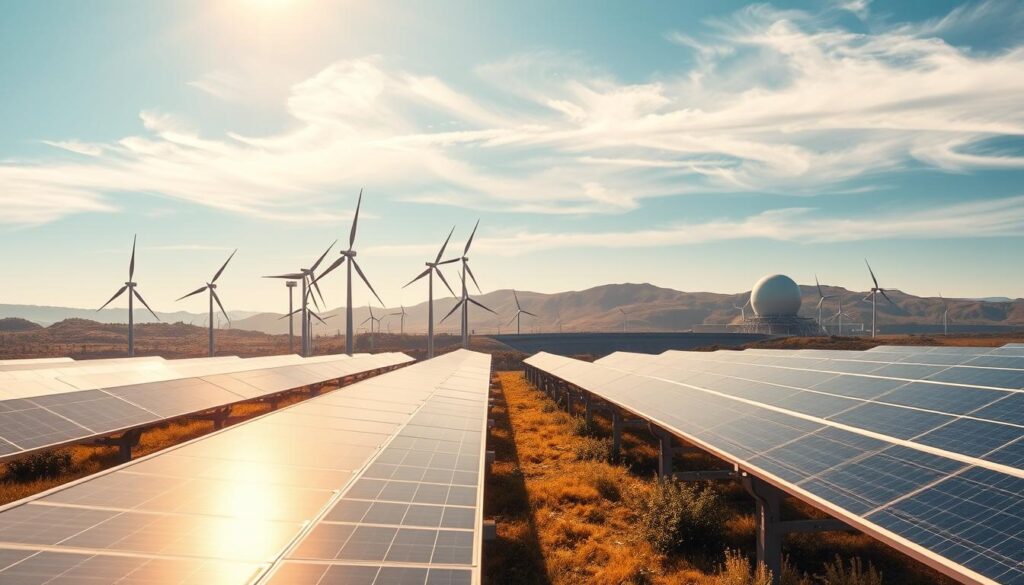
Carbon Capture and Sequestration Technologies
Carbon capture and sequestration (CCS) technologies have emerged as a crucial component in the effort to mitigate climate change. These technologies capture CO2 emissions from power plants and industrial processes, followed by storage in geological formations, thereby preventing their release into the atmosphere. CCS can reduce CO2 emissions from power plants by up to 90%, making it a vital technology for achieving significant emission reductions.
Emission Reduction Strategies in Energy Production
Emission reduction strategies in energy production are multifaceted, involving both the adoption of cleaner energy sources and the improvement of existing energy production technologies. Two key approaches include:
Clean Coal Technologies
Clean coal technologies aim to reduce the environmental impact of coal-fired power plants. These technologies include advanced combustion systems and pollution control measures that can significantly decrease emissions of pollutants and CO2. While not a long-term solution, clean coal technologies can serve as a bridge towards a cleaner energy future.
Natural Gas Transition Solutions
Natural gas is being considered as a transition fuel due to its lower carbon intensity compared to coal. Natural gas transition solutions involve the use of combined cycle gas turbines, which offer higher efficiency and lower emissions than traditional coal-fired plants. This transition can help reduce emissions in the short to medium term.
| Technology | Emission Reduction Potential | Implementation Timeline |
|---|---|---|
| Carbon Capture and Sequestration | Up to 90% | 2025-2035 |
| Clean Coal Technologies | Up to 40% | 2020-2030 |
| Natural Gas Transition | 50% compared to coal | 2020-2040 |
Power Systems Engineering and Grid Modernization
As the energy landscape evolves, power systems engineering is at the forefront of grid modernization. The integration of advanced technologies is enhancing the efficiency, reliability, and sustainability of the grid.
Smart Grid Technology Implementation
Smart grid technology is revolutionizing the way electricity is distributed and managed. By leveraging advanced sensors, IoT devices, and data analytics, utilities can optimize grid operations and improve customer engagement.
- Enhanced grid monitoring and control
- Improved outage management
- Increased customer participation through smart meters
Distributed Energy Resources Management
The increasing adoption of distributed energy resources (DERs) such as solar and wind power is transforming the traditional grid structure. Effective management of DERs is crucial for maintaining grid stability and reliability.
Microgrids and Resilience Planning
Microgrids offer a promising solution for enhancing grid resilience. By creating localized energy systems that can operate independently, microgrids can provide reliable power during outages and extreme weather events.
Key benefits of microgrids include:
- Increased energy independence
- Improved grid resilience
- Enhanced energy security
Energy Storage Integration
Energy storage plays a vital role in optimizing the performance of DERs and enhancing grid stability. By integrating energy storage systems, utilities can mitigate the intermittency of renewable energy sources and provide backup power during outages.
The combination of smart grid technology, DER management, and energy storage integration is driving the modernization of the grid, enabling a more efficient, reliable, and sustainable energy future.
Energy Modeling Software and Digital Twins
Energy modeling software and digital twins are revolutionizing the design and operation of energy systems. By creating virtual replicas of physical assets, digital twins enable real-time monitoring and predictive maintenance, significantly enhancing efficiency and reducing costs.
The integration of energy modeling software with digital twins allows for comprehensive analysis and simulation of energy systems. This synergy facilitates informed decision-making and optimization of energy performance.
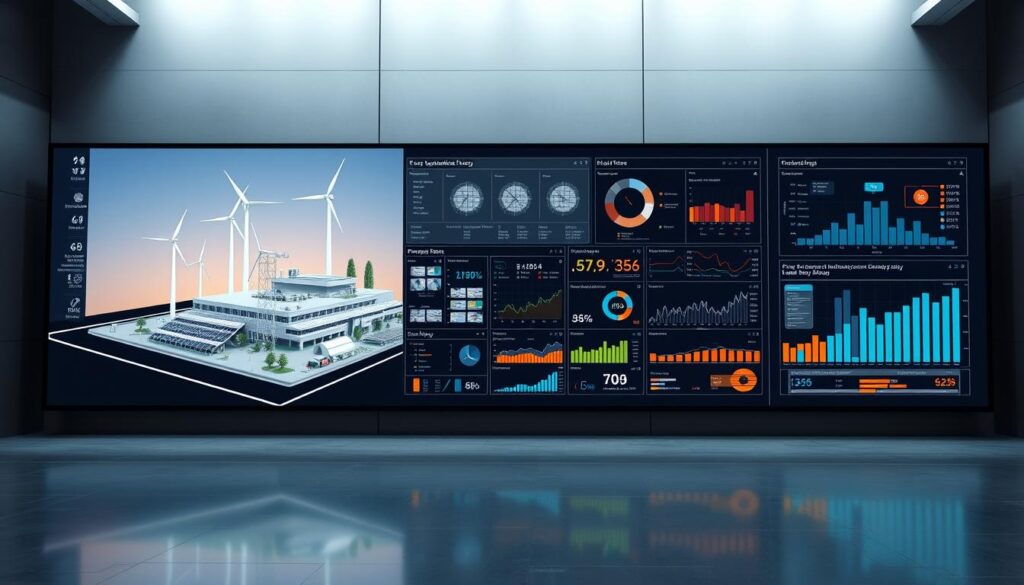
Building Energy Simulation Tools
Building energy simulation tools are crucial for analyzing and optimizing building energy performance. These tools enable architects, engineers, and building managers to predict energy consumption, identify potential savings, and evaluate the impact of different design scenarios or retrofit measures.
Some of the key features of building energy simulation tools include:
- Detailed energy modeling
- Analysis of HVAC systems
- Daylighting and lighting analysis
- Thermal comfort analysis
Grid Modeling and Optimization Software
Grid modeling and optimization software is essential for managing the complexities of modern energy grids. These tools help utilities and grid operators to model, analyze, and optimize grid performance, ensuring reliability and efficiency.
| Feature | Description | Benefits |
|---|---|---|
| Load Forecasting | Predictive analysis of energy demand | Improved grid stability, reduced costs |
| Renewable Integration | Analysis of renewable energy sources | Enhanced sustainability, reduced emissions |
| Grid Optimization | Optimization of grid operations | Increased efficiency, reduced losses |
Machine Learning Applications
Machine learning applications are increasingly being used in energy modeling software to improve predictive accuracy and optimize energy systems. By analyzing historical data and identifying patterns, machine learning algorithms can forecast energy demand and detect potential issues.
Real-time Monitoring Systems
Real-time monitoring systems are critical for the effective operation of digital twins. These systems enable continuous monitoring of energy infrastructure, allowing for immediate response to changes or anomalies.
Key benefits of real-time monitoring systems include improved reliability, reduced downtime, and enhanced operational efficiency.
The Future of Energy Engineering Innovation
Energy engineering is on the cusp of a revolution, with emerging technologies and cross-disciplinary approaches transforming the way we produce and use energy. This transformation is crucial for meeting global energy demands sustainably.
Emerging Research Areas and Breakthroughs
Researchers are exploring new frontiers in energy engineering, including advanced materials and technologies that can enhance energy efficiency and reduce environmental impact. Breakthroughs in these areas are expected to drive significant advancements in the field.
Cross-disciplinary Approaches to Energy Challenges
Addressing complex energy challenges requires a multi-faceted approach, combining insights from various disciplines such as engineering, physics, and environmental science. This cross-disciplinary collaboration is fostering innovation and leading to more effective solutions.
Nanotechnology in Energy Applications
Nanotechnology is being applied to energy applications, including the development of more efficient solar cells and advanced energy storage systems. These innovations have the potential to significantly enhance energy efficiency and reduce costs.
Artificial Intelligence for Energy Optimization
Artificial intelligence (AI) is being used to optimize energy systems, predict energy demand, and improve the efficiency of energy infrastructure. AI-driven solutions are expected to play a critical role in the future of energy engineering.

| Technology | Application | Benefit |
|---|---|---|
| Nanotechnology | Energy Storage | Enhanced Efficiency |
| Artificial Intelligence | Energy Optimization | Improved Performance |
| Cross-disciplinary Approaches | Energy Challenges | Innovative Solutions |
Energy Policy Development and Regulatory Frameworks
As the world transitions to cleaner energy sources, the importance of robust energy policies and regulatory frameworks cannot be overstated. Effective energy policy development is crucial for promoting the adoption of renewable energy technologies and reducing our reliance on fossil fuels.
United States Energy Policies and Incentives
The United States has implemented various energy policies and incentives to encourage the development and use of renewable energy. These include tax credits for renewable energy projects, net metering laws, and renewable portfolio standards (RPS) that require utilities to generate a certain percentage of their electricity from renewable sources.
Key US Energy Policies:
- Production Tax Credit (PTC) for wind energy
- Investment Tax Credit (ITC) for solar energy
- Renewable Portfolio Standards (RPS)
International Agreements and Cooperation
International cooperation is vital for addressing global energy challenges. Agreements like the Paris Agreement bring countries together to combat climate change by reducing greenhouse gas emissions and promoting the use of renewable energy.
Carbon Pricing Mechanisms
Carbon pricing mechanisms, such as carbon taxes and cap-and-trade systems, are being implemented worldwide to provide a financial incentive for reducing emissions. These mechanisms help to level the playing field for renewable energy technologies by making fossil fuels more expensive.
Renewable Portfolio Standards
Renewable Portfolio Standards (RPS) are policies that require utilities to generate a certain percentage of their electricity from renewable sources. RPS policies have been effective in driving the adoption of renewable energy in various countries and states.

| Policy/Incentive | Description | Impact |
|---|---|---|
| Production Tax Credit (PTC) | Tax credit for wind energy production | Increased wind energy development |
| Renewable Portfolio Standards (RPS) | Requires utilities to use renewable energy | Driven adoption of renewable energy |
| Carbon Pricing | Financial incentive for reducing emissions | Reduced greenhouse gas emissions |
Career Pathways in Energy Engineering
Energy engineering is a dynamic field that offers a wide range of career opportunities for those passionate about innovation and sustainability. As the world continues to transition towards cleaner energy sources, the demand for skilled professionals in this field is on the rise.
Educational Requirements and Specializations
To pursue a career in energy engineering, one typically needs a strong educational foundation in a relevant field such as mechanical engineering, electrical engineering, or environmental science. Specializations in renewable energy technologies, energy efficiency, and sustainable development are particularly valuable.
Many professionals in this field hold bachelor’s or master’s degrees, and some may also pursue certifications or advanced degrees for specialized roles. The educational pathway chosen can significantly impact one’s career trajectory and opportunities for advancement.
Industry Demand and Growth Sectors
The energy engineering sector is experiencing significant growth, driven by the global push for renewable energy sources and reduced carbon emissions. Key growth sectors include:
- Renewable energy development and integration
- Energy efficiency consulting
- Sustainable infrastructure development
Renewable Energy Career Opportunities
Careers in renewable energy are diverse, ranging from solar and wind energy development to hydroelectric and geothermal power. Professionals in this field work on designing, implementing, and maintaining renewable energy systems, ensuring a sustainable energy future.
Energy Efficiency Consulting Roles
Energy efficiency consulting is another critical area within energy engineering, focusing on optimizing energy use in buildings, industries, and other sectors. Consultants work with clients to identify energy-saving opportunities and implement efficient solutions, reducing energy consumption and costs.

| Career Path | Educational Requirement | Growth Prospects |
|---|---|---|
| Renewable Energy Engineer | Bachelor’s in Engineering | High |
| Energy Efficiency Consultant | Bachelor’s in Environmental Science or Engineering | High |
| Sustainable Development Specialist | Master’s in Environmental Science or Sustainability | Moderate |
Case Studies: Transformative Energy Engineering Projects
As the world transitions to a more sustainable energy mix, energy engineering projects are playing a crucial role. These projects are not only reducing our reliance on fossil fuels but also driving innovation in the energy sector.
Large-Scale Renewable Energy Implementations are a key aspect of modern energy engineering. For instance, the development of massive solar farms and wind parks has significantly increased the global renewable energy output. These projects demonstrate the feasibility of transitioning to a low-carbon economy.
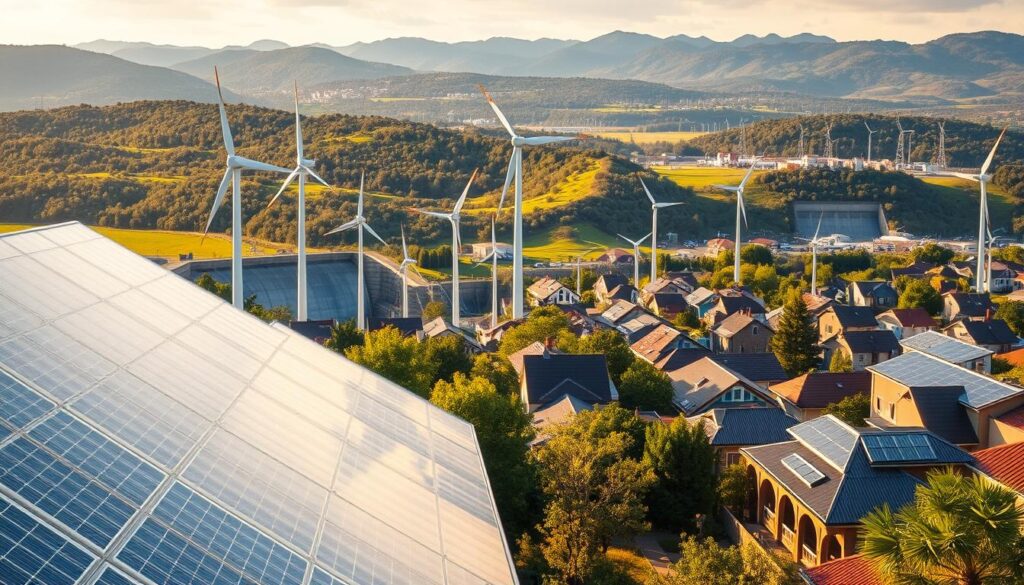
Large-Scale Renewable Energy Implementations
One notable example is the Desert Sunlight Solar Farm in California, USA, which spans over 3,900 acres and generates enough electricity to power approximately 180,000 homes. Such large-scale renewable energy implementations are crucial for reducing greenhouse gas emissions and mitigating climate change.
Community-Based Sustainable Energy Solutions
On a smaller scale, community-based sustainable energy solutions are empowering local communities to take control of their energy needs. For example, community solar programs allow multiple individuals or organizations to share the benefits of a single solar array, making renewable energy more accessible to a wider audience.
These community-based initiatives not only promote energy sustainability but also foster community engagement and education on energy issues. By examining these case studies, we can gain valuable insights into the practical application of energy engineering principles and their potential to drive positive change.
Conclusion: Embracing a Sustainable Energy Future
As we look to the future, it is clear that energy engineering will play a pivotal role in shaping a more sustainable energy landscape. By embracing innovative technologies, strategies, and policies, we can work towards a future where energy is produced, consumed, and managed in a way that is environmentally sustainable, economically viable, and socially equitable.
The energy engineering role is crucial in this transition, driving the development and implementation of sustainable energy solutions. As the world continues to evolve, the importance of energy engineering in creating a sustainable energy future cannot be overstated.
By investing in energy engineering and committing to realizing the potential of sustainable energy solutions, we can create a brighter future for generations to come. This involves not only adopting renewable energy technologies but also optimizing energy efficiency and promoting sustainable practices across industries and communities.
